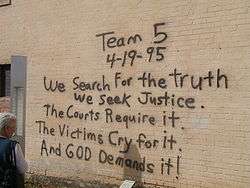Journal Record Building
|
India Temple Shrine Building | |
 | |
  | |
| Location | 621 N. Robinson Ave., Oklahoma City, Oklahoma |
|---|---|
| Coordinates | 35°28′25″N 97°30′58″W / 35.47361°N 97.51611°WCoordinates: 35°28′25″N 97°30′58″W / 35.47361°N 97.51611°W |
| Area | 1 acre (0.40 ha) |
| Built | 1923 |
| Architect | Layton, Hicks & Forsyth |
| Architectural style | Classical Revival |
| NRHP Reference # | 80003286[1] |
| Added to NRHP | March 26, 1980 |
The Journal Record Building, also known as the Law Journal Record Building and the India Temple Shrine Building, is a Classical Revival style building in Oklahoma City, Oklahoma. It was completed in 1923 and listed on the National Register of Historic Places in 1980.[1] It was damaged in the 1995 Oklahoma City bombing and now houses the Oklahoma City National Memorial Museum.
History

The 16 Masonic lodges of Oklahoma City combined their resources to construct a building large enough to house all of their activities. They hired the prominent local architectural firm of Layton, Hicks and Forsyth to design their building. Construction of the India Temple Shrine Building was started in October 1922 and completed the following year at a cost of $1.3 million.[2]
Financial conditions during the Great Depression forced the Masons to vacate the India Temple Shrine Building less than 10 years after it opened. It sat empty until December 1945, when it was sold at auction to Joe D. Morris, president and founder of the Home State Life Insurance Company. Morris paid $201,000 for the building, which he converted to office space.[2]
The building was sold in December 1977 to Dan Hogan, owner of the Law Journal Record Publishing Company, and underwent additional interior renovations in 1978.[2]
The Journal Record Building received significant damage in the Oklahoma City bombing of April 19, 1995, which destroyed the nearby Alfred P. Murrah Federal Building. Following the bombing, the building was restored and became the home of the Oklahoma City National Memorial Museum, an affiliate of the National Park Service. It also houses the National Memorial Institute for the Prevention of Terrorism.[3]
Architecture and decor
The building is a six-story Neoclassical structure measuring 260 feet (79 m) by 140 feet (43 m). Two sides are faced with limestone and decorated with Ionic columns; the remaining two sides are unornamented and faced with brick. The exterior has undergone few changes other than the 1947 addition of an entryway constructed of limestone blocks and marble columns.[2]
The original centerpiece of the building was the Shrine Auditorium, with 2,062 seats, a 44-foot (13 m) by 80-foot (24 m) stage, 2,400 lights, and a pipe organ with 3,000 pipes that cost $30,000. It was described as the second largest auditorium in the American West.[2] When built, the rooms and halls throughout the building were ornately decorated in styles including Egyptian, Greek, Roman and Byzantine. By 1947, most of the ornamentation was gone as a result of the remodeling directed by Morris, but the auditorium was retained for use as a theatre and cinema. The theatre was successful at first, but its finances declined, and in 1952 the auditorium was gutted and the space was converted to office use.[2]
References
- 1 2 National Park Service (2009-03-13). "National Register Information System". National Register of Historic Places. National Park Service.
- 1 2 3 4 5 6 Bob L. Blackburn, India Temple Shrine Building or Law Journal Record Building; National Register of Historic Places Nomination Form, Oklahoma County Historical Society, August 14, 1979
- ↑ Oklahoma City National Memorial Frequently Asked Questions, National Park Service website, accessed August 18, 2010
External links
- National Register Properties in Oklahoma: India Temple Shrine Building
- "Journal Record" in Encyclopedia of Oklahoma History and Culture